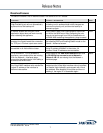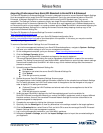
3
SonicOS Enhanced 5.6.5.1 Release Notes
P/N 232-002002-00 Rev B
Link Aggregation Link Aggregation provides the ability to group multiple Ethernet interfaces to form a trunk
which looks and acts like a single physical interface. SonicOS 5.6.5.1 supports Static Link Aggregation, in which
the two ends of the trunk have the same configuration. Up to 4 ports can be grouped to form a single aggregate
link. If any of the ports fail, SonicOS continues to pass traffic (at a diminished throughput) while there is at least
one active interface.
Link Aggregation is useful in deployments requiring more than 1 Gbps throughput for traffic flowing between two
interfaces. This feature is available on all SonicWALL NSA E-Class appliances.
Link Aggregation is supported only on SonicWALL NSA E-Class appliances.
Port Redundancy Port Redundancy provides the ability to configure a second, redundant, physical interface
for any Ethernet interface on a SonicWALL NSA E-Class appliance. When the primary interface is active, it
handles all traffic to and from the interface. If the primary interface fails, the backup interface takes over and
handles all incoming and outgoing traffic. When the primary interface comes up again, it takes over all the traffic
handling duties from the backup interface.
This is very useful in high end deployments to avoid a single point of failure, such as the connection to a switch.
With Port Redundancy, a second interface can be connected to the same or another switch to provide an
alternate path for the traffic.
Port Redundancy is supported only on SonicWALL NSA E-Class appliances.
The following are the key features supported in all versions of SonicOS 5.6:
Deep Packet Inspection of SSL encrypted data (DPI-SSL) Provides the ability to transparently decrypt
HTTPS and other SSL-based traffic, scan it for threats using SonicWALL’s Deep Packet Inspection
technology, then re-encrypt (or optionally SSL-offload) the traffic and send it to its destination if no threats or
vulnerabilities are found. This feature works for both client and server deployments. It provides additional
security, application control, and data leakage prevention functionality for analyzing encrypted HTTPS and
other SSL-based traffic. The following security services and features are capable of utilizing DPI-SSL:
Gateway Anti-Virus, Gateway Anti-Spyware, Intrusion Prevention, Content Filtering, Application Firewall,
Packet Monitor and Packet Mirror. DPI-SSL is supported on SonicWALL NSA models 240 and higher.
3G and Modem Support SonicOS 5.6 supports 3G and Modem configurations for WAN Load Balancing
(WLB). (3G and Modem support is available on all NSA models except the SonicWALL NSA 2400.)
Command Line Interface Enhancements Provides increased support through the command line
interface to configure and modify Network Address Translation (NAT) Policies, Access Rules, Service
Objects, and Service Groups.
Diagnostic Improvements Includes a diagnostic tool which automatically checks the network
connectivity and service availability of several pre-defined functional areas of SonicOS. The tool also
returns results and attempts to describe causes, if any exceptions are detected.
Dynamic DNS per Interface Provides the ability to assign a Dynamic DNS (DDNS) profile to a specific
WAN interface. This allows administrators who are configuring WAN Load Balancing to advertise a
predictable IP address to the DDNS service.
Increased DPI Connection Support Provides the ability to increase the number of simultaneous
connections on which SonicWALL security appliances can apply Deep Packet Inspection (DPI) services
(Intrusion Prevention Service, Application Firewall, Gateway Anti-Virus, and Gateway Anti-Spyware). This
feature is intended for high-end (E-Class) customers who need to support a large number of concurrent
connections. (Note: There is a slight performance decrease when this option is enabled.)
FairNet for SonicPoint-N Provides the ability to create policies that equally distribute bandwidth for all
wireless users connected to a SonicPoint-N.















